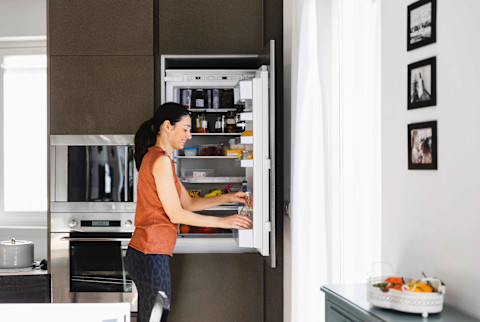4 Doctor-Approved Tips To Manage Weight & Blood Sugar In Menopause

Besides hot flashes, weight gain may be one of the most noticeable changes of menopause. While some weight fluctuations can be expected for most (we break it down here), there are a lot of internal metabolic shifts that occur before, during, or after any changes on the scale.
These changes include less efficient blood sugar management, elevated cholesterol levels, a loss of muscle mass, and fat gain—even if you keep up the same healthy habits as before. Poor metabolic health during perimenopause or menopause can also aggravate menopausal symptoms1, whereas improving your metabolic health helps ease symptoms1.
And (I know) when it's listed out like this it just seems like doom and gloom, but it's truly not. Fine-tuning your diet and movement can help you optimize your metabolic health and keep unwanted weight off. Here's what a leading women's health physician recommends:
Prioritize fiber
Most folks (95% of adults2 in the U.S. to be exact) are falling woefully short on their daily fiber intake. According to Suzanne Gilberg-Lens, M.D., FACOG, the average woman needs at least 21 grams of fiber2 (if not upward of 28 grams) daily for optimal health.
Fiber is so important for metabolic health because it helps slow down the absorption of carbs3 during digestion (therefore helping to blunt blood sugar spikes and prevent crashes). It also is super satiating so you actually feel full after a meal or snack. This is key for regulating appetite and preemptively curbing cravings.
Soluble fiber in particular plays an important role in keeping cholesterol levels in check4. This fiber forms a gel-like substance in the gut, trapping cholesterol and removing it from the body. And in the long run, high-fiber diets (we're talking about eating 35-45 grams5 of fiber a day) are also beneficial in preventing heart disease.
So it's time to stock up on high-fiber foods like oats, berries, chia seeds, whole grains, avocados, and kale. You can also lean on a fiber supplement to really level up your intake (and even help with regularity).
Eat enough protein
Protein is another nutrient that becomes more important as you age. Similar to fiber, protein also helps stabilize blood sugar levels after meals and satisfy your hunger.
But it also provides your body with amino acids to stimulate muscle protein synthesis. This process is absolutely vital for maintaining (and growing) your muscle mass.
Lean mass supports metabolic health by helping your body use blood sugar more efficiently, burn more calories at rest, and counteract body composition changes of menopause (more belly fat vs. less muscle).
Gilberg-Lens recommends that most women aim for at least 20 to 30 grams of protein at each meal (10-15 grams for snacks) to meet their daily needs. But many women, in particular, fall short on protein.
If you're not sure where to start, here's everything you need to know about upping your protein intake and whether you should use a protein powder to help you out.
RELATED READ: The 5 Best Whey Protein Powders For Muscle Growth
Lift heavy things
The second trigger of muscle protein synthesis is strength training. Gilberg-Lens recommends women start (or continue) lifting, pushing, and pulling heavy things to help build muscle mass—especially if you've previously only focused on cardio exercises like running, walking, or spinning.
And you don't have to work out every day to see the benefits. "No more than three days of intense workouts a week have been demonstrated to benefit most in older people," says Gilberg-Lens.
Nashville-based author and freelance journalist Jennifer Chesak tried a 12-week strength training program for perimenopause (working out three days a week), which has helped her sleep better, ease hot flashes, and alter her body composition.
If you're ready to try it out for yourself, check out this approachable guide to resistance training.
Daily movement
While you don't need an intense workout every day (Gilberg-Lens warns that overdoing it may make things worse), you should still get daily movement. Oftentimes counting steps is an easily trackable way to quantify this. Whether you're out for a walk, roaming around the house doing chores, or working in the garden, movement is movement.
And around 7,000 steps a day is a solid goal for most people. Want some inspo to get out and get moving? Here's how our health editors reach their daily step goal.
The takeaway
Improving your metabolic health, especially starting around the time of perimenopause (your 40s and 50s) can have a profound impact on warding off chronic conditions like heart disease and diabetes down the road by helping to manage your weight, blood sugar, cholesterol, and body composition.
Gilberg-Lens has helped thousands of women restore their health during menopause through her boot camp, and these four recommendations of hers are a great place to start. You can add a science-backed metabolism-supporting supplement routine for even more of an edge (here are our top picks).
5 Sources
- https://www.sciencedirect.com/science/article/pii/S1521693423000482
- https://www.ncbi.nlm.nih.gov/books/NBK56068/table/summarytables.t4/?rep
- https://pubmed.ncbi.nlm.nih.gov/37711348/
- https://pubmed.ncbi.nlm.nih.gov/27807734/#:~:text=Findings%20include%20the%20following%3A%20(a,cholesterol%2Dlowering%20properties%20of%20soluble
- https://www.mdpi.com/2072-6643/16/1/27

